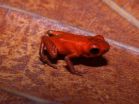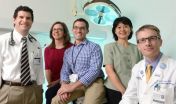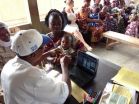(Press-News.org) Hunting from a distance of 27,000 light years, astronomers have discovered an unusual carbon-based molecule – one with a branched structure – contained within a giant gas cloud in interstellar space. Like finding a molecular needle in a cosmic haystack, astronomers have detected radio waves emitted by isopropyl cyanide. The discovery suggests that the complex molecules needed for life may have their origins in interstellar space.
Using the Atacama Large Millimeter/submillimeter Array, known as the ALMA Observatory, a group of radio telescopes funded partially through the National Science Foundation, researchers studied the gaseous star-forming region Sagittarius B2.
Astronomers from Cornell University, the Max Planck Institute for Radio Astronomy and the University of Cologne (Germany) describe their discovery in the journal Science (Sept. 26.)
Organic molecules usually found in these star-forming regions consist of a single "backbone" of carbon atoms arranged in a straight chain. But the carbon structure of isopropyl cyanide branches off, making it the first interstellar detection of such a molecule, says Rob Garrod, Cornell senior research associate at the Center for Radiophysics and Space Research.
This detection opens a new frontier in the complexity of molecules that can be formed in interstellar space and that might ultimately find their way to the surfaces of planets, says Garrod. The branched carbon structure of isopropyl cyanide is a common feature in molecules that are needed for life – such as amino acids, which are the building blocks of proteins. This new discovery lends weight to the idea that biologically crucial molecules, like amino acids that are commonly found in meteorites, are produced early in the process of star formation – even before planets such as Earth are formed.
Garrod, along with lead author Arnaud Belloche and Karl Menten, both of the Max Planck Institute for Radio Astronomy, and Holger Müller, of the University of Cologne, sought to examine the chemical makeup of Sagittarius B2, a region close to the Milky Way's galactic center and an area rich in complex interstellar organic molecules.
With ALMA, the group conducted a full spectral survey – looking for fingerprints of new interstellar molecules – with sensitivity and resolution 10 times greater than previous surveys.
The purpose of the ALMA Observatory is to search for cosmic origins through an array of 66 sensitive radio antennas from the high elevation and dry air of northern Chile's Atacama Desert. The array of radio telescopes works together to form a gigantic "eye" peering into the cosmos.
"Understanding the production of organic material at the early stages of star formation is critical to piecing together the gradual progression from simple molecules to potentially life-bearing chemistry," said Belloche.
About 50 individual features for isopropyl cyanide (and 120 for normal-propyl cyanide, its straight-chain sister molecule) were identified in the ALMA spectrum of the Sagittarius B2 region. The two molecules – isopropyl cyanide and normal-propyl cyanide – are also the largest molecules yet detected in any star-forming region.
INFORMATION:
New molecule found in space connotes life origins
2014-09-26
ELSE PRESS RELEASES FROM THIS DATE:
Scientists discover new poison dart frog species in Donoso, Panama
2014-09-26
A bright orange poison dart frog with a unique call was discovered in Donoso, Panama, and described by researchers from the Smithsonian Tropical Research Institute and the Universidad Autónoma de Chiriquí in Panama, and the Universidad de los Andes in Colombia. In the species description published this week in Zootaxa, it was named Andinobates geminisae for Geminis Vargas, "the beloved wife of [coauthor] Marcos Ponce, for her unconditional support of his studies of Panamanian herpetology."
Every new species name is based on a representative specimen. The specimen for ...
Many patients excluded from clinical trials due to prior cancer, UTSW study finds
2014-09-26
DALLAS – Sept. 26, 2014 – Lung cancer clinical trials exclude a substantial proportion of patients due to a history of prior cancer, as shown in an analysis by cancer researchers at UT Southwestern Medical Center.
Among more than 50 lung cancer clinical trials examined, more than 80 percent excluded patients with prior cancer from participating, according to the study published in the Journal of the National Cancer Institute. The exclusion criterion was even applied in more than two-thirds of trials in which survival was not the primary endpoint.
"Our research demonstrates ...
Preference for built-up habitats could explain rapid spread of the tree bumblebee in UK
2014-09-26
The strikingly rapid spread of the Tree Bumblebee in Britain could be occurring because the bees readily live alongside humans in towns and villages – according to research from the University of East Anglia.
A new study published today shows that Tree Bumblebees are associated with built-up areas and that these areas form a large part of their habitat use.
These markedly different habitat and foraging preferences set this species apart from other common British bumblebee species – which could explain how Tree Bumblebees have managed to colonise much of the UK while ...
Policies of NIH, other funders, have improved data-sharing by life-science investigators
2014-09-26
Policies put into place by major funding agencies like the National Institutes of Health (NIH), and to a lesser extent by scientific journals, appear to be meeting the goal of increasing the sharing of scientific resources among life science investigators. As reported in the open-access journal PLOS ONE, 65 percent of surveyed investigators at major U.S. research institutions believed that NIH policies instituted in recent years had markedly improved the sharing of scientific data. But the survey also identified some unexpected problems, including the number of researchers ...
The scarring effects of primary-grade retention?
2014-09-26
An article released by Social Forces titled, "The Scarring Effects of Primary-Grade Retention? A Study of Cumulative Advantage in the Educational Career" by Megan Andrew explores the effect of scarring in the educational career in the case of primary-grade retention. Just as is the case for labor-market careers, events early in the educational career can leave lasting scars. Through the study, Andrew finds that primary-grade retention has lasting effects on educational attainments well after a student is initially retained: Retaining a child in early primary school reduces ...
Smelly discovery challenges effectiveness of antimicrobial textiles
2014-09-26
Anti-odour clothing may not be living up to its promise, and an ALES researcher is saying it
could all be a matter of how the product was tested.
In two separate experiments, Human Ecology researcher Rachel McQueen and her team found that some antimicrobial textiles were far more effective at performing their advertised tasks in the lab than in testing on humans. In one experiment, the fabrics were designed to help lower the risk of infection; in the second, the fabric was treated with a silver compound, which can be marketed preventing odour in clothing.
"We aren't ...
Children with autism are more sedentary than their peers, new OSU study shows
2014-09-26
CORVALLIS, Ore. – A new Oregon State University study of children with autism found that they are more sedentary than their typically-developing peers, averaging 50 minutes less a day of moderate physical activity and 70 minutes more each day sitting.
The small study of 29 children, some with autism and some without, showed that children with autism perform as well as their typical peers on fitness assessments such as body mass index, aerobic fitness levels and flexibility. The results warrant expanding the study to a larger group of children, said Megan MacDonald, an ...
Poor fish harvests more frequent now off California coast
2014-09-26
As a child in southern California, Ryan Rykaczewski spent a fair amount of time on his grandfather's boat, fishing with him off the Pacific coast near Los Angeles. At the time, he didn't think there was much rhyme or reason to their luck on the water.
"Sometimes we'd catch a lot of fish and sometimes we didn't," he says. "I just thought it was chaotic, that we could never understand what was going on."
But education changed his mind. Now an oceanographer and assistant professor at the University of South Carolina, he's working to understand the many factors that determine ...
Scanning babies' fingerprints could save lives
2014-09-26
Each year 2.5 million children die worldwide because they do not receive life-saving vaccinations at the appropriate time.
Anil Jain, Michigan State University professor, is developing a fingerprint-based recognition method to track vaccination schedules for infants and toddlers, which will increase immunization coverage and save lives.
To increase coverage, the vaccines must be recorded and tracked. The traditional tracking method is for parents to keep a paper document. But in developing countries, keeping track of a baby's vaccine schedule on paper is largely ineffective, ...
Decision analysis can help women make choices about breast reconstruction
2014-09-26
September 26, 2014 – Decision analysis techniques can help surgeons and patients evaluate alternatives for breast reconstruction—leading to a "good decision" that reflects the woman's preferences and values, according to an article in the October issue of Plastic and Reconstructive Surgery®, the official medical journal of the American Society of Plastic Surgeons (ASPS).
The special topic article by Mia K. Markey, PhD, and colleagues of The University of Texas at Austin and The University of Texas MD Anderson Cancer Center, Houston, introduces plastic surgeons to the ...



